Since my new novel is set there, I’ve been thinking a lot about Nottingham recently, remembering the many the good and interesting things about growing up there. You can listen to the brief tour of the city and its edges that I took a few weeks ago with my mum and dad on the new episode of the Pixie-Led podcast, (you can also listen to some bonus material here if you’re a paid subscriber) and here’s another brief guide to a few Nottingham things – most of which probably won’t be so well-known to those who haven’t lived there – that I felt like celebrating:

The Park Tunnel
Few architects were more prolific in the 1800s than Thomas Chambers Hine, who designed dozens of buildings in Nottinghamshire and Derbyshire, including some of Nottingham’s most significant. Claremont, the primary school I attended on the fringe of the city’s Forest Fields area – a red brick building whose high ceilings, parquet floors and industrial pipes sometimes feel like they’re an integral part of my soul – was his work, as was the now defunct Great Northern Railway Station. In the middle of all this, he managed to also father eleven children and excavate a tunnel through the sandstone north of Nottingham castle to allow horse and cart access from Derby Road to the now very exclusive Park area. It didn’t succeed in terms of its original purpose, as he got the gradient wrong, but it’s now arguably the most beautiful and spectacular pedestrian underpass in the whole of the British isles. Once a forest which served the blood-thirsty needs of Henry II – a man who was described as “addicted to hunting beyond all measure” – The Park estate was developed during the 1800s, with the likes of Hines and Watson Fothergill building grand houses for the Nottingham manufacturing bigwigs of the century (Boots The Chemist founder Jesse Boot lived here, as did hosiery maker turned Lib Dem Cabinet Minister Anthony Mundella). In the 1930s, the ambitiously named Nottingham City Police Chief Constable Athelstan Popkess lived here, but by the 1960s many of the buildings had become a little down-at-heel, which meant that between 1969 and 1973 my mum (pictured above in the tunnel in January this year) and dad could rent a two bed flat in a prime spot for six quid a month. These days, one the same size in a similarly grand Victorian building in The Park will set you back around £1494 more, if you are prepared to compromise slightly on decor and natural light.
The Great Cheese Riot
Nottingham is a city well-practised in rioting, whether the subject be reform (1831) , the police (1981), bread (1812) or dairy products. In 1766, when farmers raised the price of cheese, the people of the city rebelled en masse and violence broke loose, with various cheeses being stolen and rolled with great velocity down Wheeler Gate in the direction of the Market Square. The chaos reached its apex when the Mayor, while attending Goose Fair, was felled by a giant cheese. There is, however, no record of what specific type of cheese did the damage.
Twitchels
The debate regarding what is the correct term for a narrow passage between buildings or hedges is one of hot feelings and intense geographical loyalty that could rage violently for eternity between the regions of the UK, especially as you move further north, but let’s face it: ginnel, snicket, jitty… none of them sound quite right. The reason we call twitchels “twitchels” in Nottinghamshire is because they’re twitchels. Just look at them! Twitchels are exactly, undeniably what they are, in every possible way. They just ooze twitchelness and twitchality. How could they be anything else? Ok. I’m glad that’s finally settled.

The Left Lion
Picture the scene: 1993. 2pm on a lazy Thursday. My friends Matt, Steve, Karina and I leave our BTEC course a couple of hours early and head into town from the vast grey suburb of Clifton. There doesn’t seem to be much going on in college that day, there’s a reduced price Sebadoh CD I’ve got my eye on in Selectadisc, and I probably won’t bother going in at all tomorrow since it’s two long bus rides for me, I’ll be hungover and all we’ve got is Politics with whassisname. We head our separate ways and arrange to meet in the Market Square at the Left Lion statue at 7pm, from where we will proceed to Langtry’s, The Salutation or The Bell, then Student Night at Rock City. What if one or more of us is late? Dunt matter. We’ll work it out, yoth. We all know where we’re going. Why the Left Lion, and not the Right Lion? Maybe because out of the two supposedly identical feline statues designed by Joseph Else for the Nottingham Council House’s opening in 1929, it seems slightly less pissed off, slightly cleaner and more welcoming, but mainly because it’s Nottingham folklore: left is best. Everyone who knew anything knew it in 1993 and it’s just the same now. We did try the right one one time purely as an experiment but it felt wrong. The night soon turned dark. Our usual nook in the pub was occupied, the DJ didn’t play Mr Pharmacist by The Fall, the hot boy whose hair Karina liked didn’t turn up, someone puked on Steve’s favourite coat and my car stereo got nicked in St Annes the following day. We realised our mistake and would not be so reckless again.

The Hemlock Stone
Dartmoor has The Bowerman’s Nose, Gloucestershire has the Devil’s Chimney, Nottingham has The Hemlock Stone. Our best-known freak geological folk protuberance might be grimier than its southern equivalents but it has its witchy stories too, the most famous being that The Devil threw it into its current location when he was attempting to smash up Lenton Priory, owing to the sound of the monks ringing the bells there getting royally on his tits. Just a little later, in 1960, my dad’s gang from nearby Stapleford, led by his cousin Flob, climbed all 28 feet of the Hemlock Stone, the senior members helping my dad, who was only 11 at the time, up onto the top ledge. The well-known blackening of the stone is generally thought to be a residual build up from industrial air pollution but my dad claims it’s a remnant of the day a short time after that when Flob and his mates tried to set fire to it.
If you’d like to pre-order a copy of my next (Nottinghamshire-based) novel, 1983, you can do so here and contribute to its funding in the process.
My previous novel, Villager, will be published in paperback on March 30th.
You can subscribe to this website via the homepage and to my Substack page via this link.

